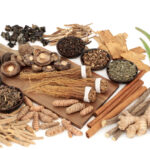by: January 5, 2025
 (NaturalHealth365) While infertility can be a frustrating and emotionally fraught condition, it is by no means rare. According to a recent report from the Pew Research Center, over 40 percent of all American adults have either had fertility treatments or know someone who has.
(NaturalHealth365) While infertility can be a frustrating and emotionally fraught condition, it is by no means rare. According to a recent report from the Pew Research Center, over 40 percent of all American adults have either had fertility treatments or know someone who has.
An increasing number of people are turning to Ayurveda, a holistic approach that combines natural remedies, proper diet, spiritual elements, and lifestyle changes to help with fertility. However, scientific research on this ancient practice has been limited – until recently. A new review published in Cureus highlights the effects of Ayurvedic herbs on infertility and female reproductive health.
In particular, four of the Ayurvedic herbs stood out for their impressive therapeutic effects. Let’s see what these time-honored natural remedies can do.
Ayurvedic herbs such as ginger can help target polycystic ovary syndrome
The single most common cause of female infertility is polycystic ovary syndrome (PCOS), which affects up to 15 percent of women of childbearing age. In PCOS, the ovaries create excessive amounts of hormones such as androgen, luteinizing hormone, follicle-stimulating hormone, and estrogen, resulting in an imbalance. However, the new review shows that Ayurvedic herbs can help to regulate these hormones.
The authors cited a 2020 study published in Studies in Medical Sciences that showed that 12 weeks of ginger supplementation and pilates training helped substantially reduce luteinizing hormone, testosterone, and insulin levels in women with PCOS. The researchers credited ginger with “beneficial effects” on ovarian function and supported its use as a therapy for PCOS. They concluded that Ayurveda could be used as a complementary therapy, noting that Ayurvedic herbs often had a synergistic effect that helped strengthen the combined impact of Western and Ayurvedic treatments.
Could Ayurvedic herbs be “anticancer superheroes?” Antioxidant compounds in ginger may help fight ovarian cancer
This wasn’t the only good news for ginger. The authors concluded it had the widest range of applications for female reproductive health of all Ayurvedic herbs assessed in the review.
Botanically known as Zingiber officinale, ginger root is rich in antioxidant and anti-inflammatory compounds known as shogaols and gingerols. These two active constituents in ginger show the potential to help treat and prevent cancer.
For example, multiple lab studies have shown that shogaols can strongly inhibit ovarian cancer cells. In addition, ginger can help manage painful periods, also known as dysmenorrhea.
In a study published in Pakistan BioMedical Journal, a combination of ginger and vitamin E helped to substantially reduce pain levels and improve the quality of life in young women with dysmenorrhea. Yet another of ginger’s gifts to female health is its ability to relieve nausea and vomiting during pregnancy. Of course, check with your obstetrician before trying ginger for pregnancy-related nausea.
Shatavari, the “Queen of Herbs,” equals the effects of pharmaceutical medication in triggering ovulation
Derived from the roots of the plant botanically classified as Asparagus racemose, shatavari contains steroidal saponins that can balance female hormones. So, it’s no surprise that it’s known in Ayurveda as the Queen of Herbs and is valued for its fertility-inducing effects.
In a controlled trial published in the International Journal of Contraception, Obstetrics, and Gynecology, researchers found that shatavari’s effects on stimulating follicular growth and triggering ovulation in participants were directly comparable to those of clomiphene citrate, a fertility-inducing pharmaceutical drug. Thus, the “Queen” of Ayurvedic Herbs could be an alternative fertility treatment for women unable to tolerate the side effects of pharmaceutical drugs.
Turmeric and ashwagandha can balance hormones, easing dysmenorrhea and menopausal symptoms
Turmeric, or Curcuma longa, is widely considered the “gold standard” of herbal interventions for inflammation – so it’s appropriate that the turmeric root is golden in color. Its active compound is curcumin, a natural plant pigment with powerful anti-inflammatory, antioxidant, and anti-cancer properties. Studies suggest that curcumin can help target the inflammation, obesity, and insulin resistance that contribute to PCOS.
Like ginger, curcumin-rich turmeric has shown promise in treating painful periods and menopause symptoms. In a study published in the Journal of Surgery and Medicine, turmeric-enriched water significantly decreased pain in young adult females with dysmenorrhea. Turmeric has also been utilized to alleviate symptoms associated with menopause, such as hot flashes, mood changes, and insomnia.
Ashwagandha (Withania somnifera), also called winter cherry, is another ally you can enlist to help balance hormones and ease menopause symptoms. It is cherished in Ayurveda as an adaptogen, meaning it can promote vitality and help the body cope with stress.
The review authors cited a 2021 study published in the Journal of Obstetrics and Gynaecology Research in which ashwagandha reduced menopause symptoms such as hot flashes and insomnia while improving quality of life, prompting the team to conclude that this versatile Ayurvedic herb “could help with menopause symptoms.
As with any herbal intervention, consult your holistic doctor before using curcumin, shatavari, or ashwagandha.
Pointing out that the global community is currently grappling with Western medicine’s limitations and side effects, the review authors called for a “paradigm shift” that would allow Ayurvedic herbs to be used alongside it. Only time will tell if practitioners of Western medicine will listen – and fully embrace the ancient healing wisdom of Ayurveda. Until then, we will remain hopeful.
Sources for this article include:
Pewresearch.org
IJRCog.org
ClevelandClinic.org
Wiley.com
Wiley.com
Umsu.ac.ir
Pakistanbmj.com
Planetayurveda.com
Jsurgmed.com
No hay comentarios:
Publicar un comentario